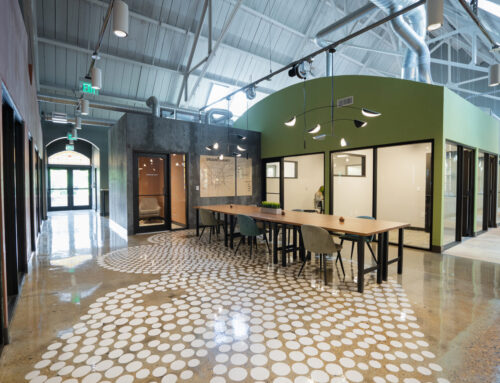As someone who has worked both in the office and remotely throughout her career, I know just how important it is to keep the company culture going whether you’re tethered into the office or working from home. The world has shifted into a nebulous of in-office time, hybrid concepts, coworking spaces, and remote work. All of these options offer pros and cons, but there is one thing that holds everything together no matter how your team is working everyday: a strong culture.
What is company culture?
Throughout my career, I have experienced many different types of company cultures. From Fortune 500 companies to being the third person on a new startup, the culture at each company I landed in was very different. Some I loved, others I hated. A lot of them I didn’t know much about.
Company culture is one of the most overlooked pieces of doing business. I know many large companies feel the good of culture in their hearts, but many of them forget about it as they grow. Like a new plant you just bought at the nursery, a good company culture needs nurturing to grow. If you don’t nurture your culture and look after it regularly, you will be in sad shape.
Culture is how you define many aspects of business related to the people who work at your organization. The way you work together, individually, and with external partners is one piece of what you should define here. A more important piece is your expectations and values around the people you work with, including but not limited to: communication guidelines, founder values and purpose, who you serve and why, etc.,
You either have this or you don’t. If you don’t have a culture, now is the time to start building it!
Building a team 101
Now that I know what a good culture can do for my team, I know culture building is imperative across all boundaries of work. To start building my team’s culture, I piggybacked off our company’s values and mission statement because all of our work ties heavily back into what the company’s goals are. I won’t list them all here, but you can see what we’re about on our Impact website and on our About page.
Every team member knows these values and our mission statement, but we realized as a team we wanted to set some expectations of how we work together, individually, and with our external teams and members. We sat down as a team and added more to our team’s culture by tying in what was most important to us as individuals, as well as a few communication guidelines so we could all be on the same page.
Boom. That was it. We created our culture on paper and it felt good. But I didn’t stop there.
Our team needed to activate on these bullet points in real life and that’s where the next question gets a little complicated if you have a hybrid or remote team.
How did we build a remote work culture & activate it?
We had the traditional culture document. It was epic and beautiful, but as a hybrid team with a remote working manager, the challenge was set. One of the hardest things about building a remote work or hybrid work culture is that you have more obstacles than you do when you sit in an office with every person on your team. But we all know this by now.
I work from home every day because I am over one thousand miles away from my team and our headquarters. Most of my team is based near our headquarters and I have one other employee in another city where we have locations. Our team is diverse and every one of them works differently than the other. We’re not just talking the difference between to-do lists and meeting styles either.
Some of our team members get to work before 8AM, others show up at 9AM. Some like more communication and team meetings than others. Some like to work on their own more than with the team and vice versa. But despite the differences in work styles, we still agreed on our team culture and stood by our company culture, too. We just had to put it into action.
And here’s how we did it.
Things we did to build a great remote work culture:
- Have team meetings on a regular basis: One of the hardest things about working remotely or with people across different time zones and schedules is staying in contact. That’s why we meet twice a week as a team to review projects, get company wide updates, and check-in on challenges.
- Create a virtual water cooler: Most of our team is distributed across one of our cities, but for those of us who aren’t nearby, we’ve found it beneficial to add a virtual watercooler chat to our slack team where we goof off, answer survey questions, and send photos of our weekend or events that went on during the week.
- Consistently schedule social interactions: It may sound silly, but I strongly believe that our team is closely bonded because we consistently have 1-2 happy hours per month, have fun themes for a handful of team meetings, and celebrate our team and individual wins when they happen, not when it’s convenient. For our virtual team members, we hop on a call with our in-person team members and celebrate, chat, and play games together from wherever we are!
- Focus on community engagement: Outside of our team, we support each other’s passions and goals. We take days off to volunteer at organizations we care about in the places we live and give small acts of kindness to people inside and outside of our team who need a pick-me-up or have a big win to share. I also encourage my team to get to know each other. Text, call, grab a drink, meet up for lunch…whatever it takes to get to know the people we work with and understand them a bit better.
- Practice asynchronous work: Because everyone works differently, I allow for asynchronous work, or the ability to be online or at work at different times. Despite me living in the western United States, I work Eastern Standard Time hours because I know I can best support my team during that time. But I also allow my team to make the best choice for them if they need to run to an appointment or want to go meet their parents for lunch. I trust that the work will get done because 1) we’re not an emergency hospital and 2) because I hire great people who follow our company and team cultures.
It’s not simple or easy. We have days where communication is hard and staying consistent is more difficult than I’d like to admit, but we are committed to being the best we can be for the company and most importantly for each other to have the work life that works for us.
Don’t believe me? Here’s a quote from one of my team members about what it’s like to work in a hybrid and remote work environment.
“Working in the hybrid work environment has been extremely productive. Having a manager that empowers you to work the way that makes you the most successful means I can pop around to any of our locations and even work from home when I need it. When you have an open line of communication and the common goal of wanting the business to succeed and grow, WHERE you work doesn’t matter.” – Natalie Kokoska, Digital Marketing & Communications Manager
Culture is what holds us together
With everything I said in mind, the most important thing to take away from working remotely or in a hybrid environment is that culture is still the glue to how we work. No matter how we work, we still need something to bring our team and our purpose together. Without culture, we are left with cubicles of people, Zoom screens full of glossy-eyed employees, and no real motivation to keep it all going.
Whether you are managing a team of remote workers, working remotely on a team, or working in a hybrid work environment or coworking space, it’s time to bring culture to your physical or virtual table.
Erin Maxson: Head of Marketing & Technology at COhatch



